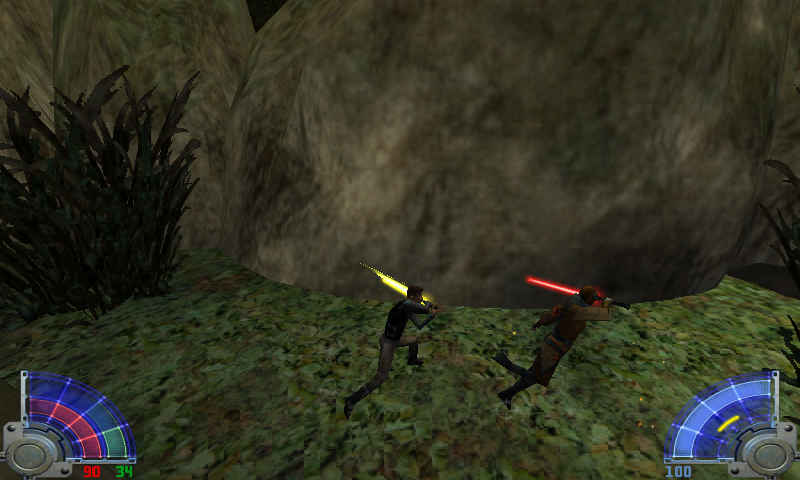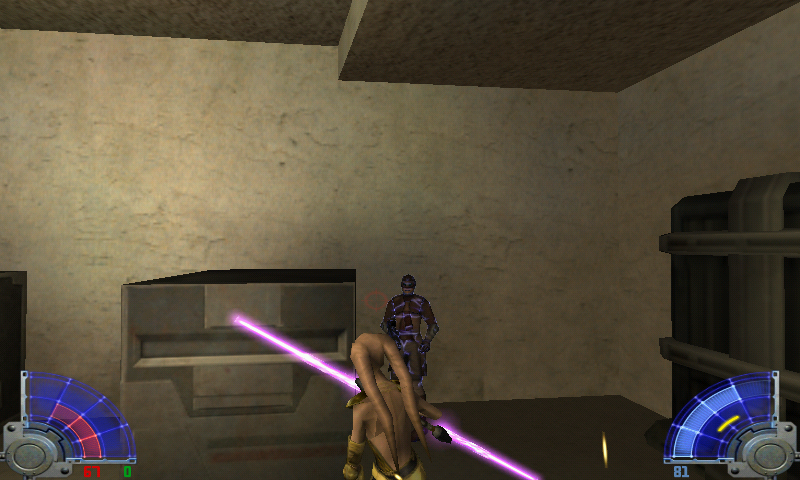ptitSeb
Serial Porter
Here is the Full version Jedi Knight 3: Jedi Academy.

You need Data files to make it runs. Install Full (or Demo) version on a PC or using Wine (no need to update to v1.01) and copy the "base" folder to your appdata/jediacademy folder.
If you don't own the full game, you can try the Demo version, Ready2Run here. If you already have the demo, you can use the full version that also support Demo data.
The Demo feature 2 levels from the full game, but you play them with more advanced powers (mainly for the Moss Esley level).

This one share a lot of code with Jedi Knight II, so I mostly repeat what's on JK2 thread.
Key layout as been adapted to the Pandora, and it's JK2 control (simplified, no inventory here):
D-PAD to Move (left/right is Strafe)
Right nub to move the camera
Jump: {X}
Force: {A}
Crouch: {B}
Interact: {Y}
Prev Force: O
Next Force: P
Prev Weapon: K
Next Weapon: L
Lightsaber Style: Y
Toggle Perspective: M
Change Weapons: Number keys
Datapad : {start}
force grip N
force speed B
force distract G
force heal H
force throw I
force lightning J
force pull U
Open Console D
Close Console TAB
About performances, this game can be slow on some areas, mainly large room/open space with lots of round objetcs (pipes), and/or when many guys are active (many = more than 5 or 6).
32bits and 16bits Textures are supported, but not compressed texture.
Also, OpenAL is not working perfectly, and is eating a lot of perf. So disable "EAX" (it is by default) for better performances (you need build 02+ for that).
For CC Pandora model, you should use "low" texture resolution (it's medium by default), and stick to 16bits, because of memory constraint.
For Rebirth, you can choose medium, but you should stay at 16bits.
And an hint: you can use (at least on Gigahertz model) "medium" for geometry, and it was running as well as "low", just prettier !
Also, note that on Gigahertz model, on certain level (like the 1st one), you may experience a few graphical glitches when using default drivers. You'll be warned about that on 1st start. The glitches disapears when using beta newer driver. There are not too annoying anyway.
History log
========
Build 06
-----------
-----------
-----------
Build 03
-----------
-----------
Build 01
-----------
For those interested, here are the sources. Well, it's a diff of the git sources: , and the diff from build 04: jediacademy_pandora.tar.gz
I have declared 5 #define this time. So beside the usual "PANDORA" (for pandora specifics, like screensize or buttons), and "HAVE_GLES", you'll find "ARM" (to avoid x86 assembly), "NEON" (for Neon specifics optimisations) and AUTOAIM (for the Aim Assist code).
You can also find everything on this git: https://github.com/ptitSeb/JediAcademyLinux

You need Data files to make it runs. Install Full (or Demo) version on a PC or using Wine (no need to update to v1.01) and copy the "base" folder to your appdata/jediacademy folder.
If you don't own the full game, you can try the Demo version, Ready2Run here. If you already have the demo, you can use the full version that also support Demo data.
The Demo feature 2 levels from the full game, but you play them with more advanced powers (mainly for the Moss Esley level).

This one share a lot of code with Jedi Knight II, so I mostly repeat what's on JK2 thread.
Key layout as been adapted to the Pandora, and it's JK2 control (simplified, no inventory here):
D-PAD to Move (left/right is Strafe)
Right nub to move the camera
Jump: {X}
Force: {A}
Crouch: {B}
Interact: {Y}
Prev Force: O
Next Force: P
Prev Weapon: K
Next Weapon: L
Lightsaber Style: Y
Toggle Perspective: M
Change Weapons: Number keys
Datapad : {start}
force grip N
force speed B
force distract G
force heal H
force throw I
force lightning J
force pull U
Open Console D
Close Console TAB
About performances, this game can be slow on some areas, mainly large room/open space with lots of round objetcs (pipes), and/or when many guys are active (many = more than 5 or 6).
32bits and 16bits Textures are supported, but not compressed texture.
Also, OpenAL is not working perfectly, and is eating a lot of perf. So disable "EAX" (it is by default) for better performances (you need build 02+ for that).
For CC Pandora model, you should use "low" texture resolution (it's medium by default), and stick to 16bits, because of memory constraint.
For Rebirth, you can choose medium, but you should stay at 16bits.
And an hint: you can use (at least on Gigahertz model) "medium" for geometry, and it was running as well as "low", just prettier !
Also, note that on Gigahertz model, on certain level (like the 1st one), you may experience a few graphical glitches when using default drivers. You'll be warned about that on 1st start. The glitches disapears when using beta newer driver. There are not too annoying anyway.
History log
========
Build 06
-----------
- Added support for Hardware Gamma
- Fresh build
-----------
- Added "noshouldermb" support
- Tear free glSwapBuffer
- Fresh compile (faster?)
-----------
- Added Joystick support, in true analogic mode (including a rolling-evade that works)
- Configure Left Nub as Joystick
- New default config file (optionnal) to automaticaly use the nub joystick.
- Toggle Crouch (smart version, that doesn't interfere with evade action)
- Added 2 config file to change behavour of nubs (see left_nub and right_nub in the home folder of appdata)
- Use Right shoulder for Left clic and Left Shoulder for Right clic
Build 03
-----------
- Many GLES optimisation, especialy in volumetric shadow and "quicksprite" (used on many surface). Better framerates
- Many fixes to GLES renderer (mainly weather effect and shadow).
- Fixed Mouse Y axis acceleration, that should be slower and not faster than X axis
- Some fixes/refinement in the launch script
-----------
- Added ability to disable use of OpenAL (unselect EAX). It was forced on before. Better performances, and some buggin sounds solved.
- New refined default layout, with direct Force access, thanks to Askarus (no need to delete, you will have a question to upgrade or not)
Build 01
-----------
- Initial build
- Pandora controls
- Adapted to OpenGLES-1
- some neon optimizations
For those interested, here are the sources. Well, it's a diff of the git sources: , and the diff from build 04: jediacademy_pandora.tar.gz
I have declared 5 #define this time. So beside the usual "PANDORA" (for pandora specifics, like screensize or buttons), and "HAVE_GLES", you'll find "ARM" (to avoid x86 assembly), "NEON" (for Neon specifics optimisations) and AUTOAIM (for the Aim Assist code).
You can also find everything on this git: https://github.com/ptitSeb/JediAcademyLinux
Attachments
Last edited:

